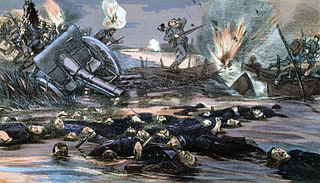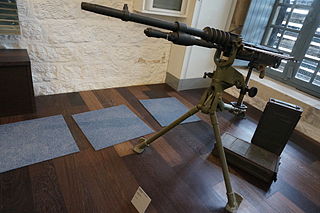
A military armoredcar is a wheeled armored fighting vehicle, historically employed for reconnaissance, internal security, armed escort, and other subordinate battlefield tasks. With the gradual decline of mounted cavalry, armored cars were developed for carrying out duties formerly assigned to light cavalry. Following the invention of the tank, the armored car remained popular due to its faster speed, comparatively simple maintenance and low production cost. It also found favor with several colonial armies as a cheaper weapon for use in underdeveloped regions. During World War II, most armored cars were engineered for reconnaissance and passive observation, while others were devoted to communications tasks. Some equipped with heavier armament could even substitute for tracked combat vehicles in favorable conditions—such as pursuit or flanking maneuvers during the North African campaign.

The First Battle of Ypres was a battle of the First World War, fought on the Western Front around Ypres, in West Flanders, Belgium. The battle was part of the First Battle of Flanders, in which German, French, Belgian armies and the British Expeditionary Force (BEF) fought from Arras in France to Nieuwpoort (Nieuport) on the Belgian coast, from 10 October to mid-November. The battles at Ypres began at the end of the Race to the Sea, reciprocal attempts by the German and Franco-British armies to advance past the northern flank of their opponents. North of Ypres, the fighting continued in the Battle of the Yser (16–31 October), between the German 4th Army, the Belgian army and French marines.

The Battle of the Yser was a battle of the First World War that took place in October 1914 between the towns of Nieuwpoort and Diksmuide, along a 35 km (22 mi) stretch of the Yser River and the Yperlee Canal, in Belgium. The front line was held by a large Belgian force, which halted the German advance in a costly defensive battle.
The Canadian Expeditionary Force (CEF) was the expeditionary field force of Canada during the First World War. It was formed following Britain’s declaration of war on the German Empire on 15 August 1914, with an initial strength of one infantry division. The division subsequently fought at Ypres on the Western Front, with a newly raised second division reinforcing the committed units to form the Canadian Corps. The CEF and corps was eventually expanded to four infantry divisions, which were all committed to the fighting in France and Belgium along the Western Front. A fifth division was partially raised in 1917, but was broken up in 1918 and used as reinforcements following heavy casualties.

The Mle 1914 Hotchkiss machine gun chambered for the 8mm Lebel cartridge became the standard machine gun of the French Army during the latter half of World War I. It was manufactured by the French arms company Hotchkiss et Cie, which had been established in the 1860s by American industrialist Benjamin B. Hotchkiss. The gas-actuated Hotchkiss system was first formulated in 1893 by Odkolek von Ujezda and improved into its final form by Hotchkiss armament engineers, American Laurence Benét and his French assistant Henri Mercié.

The Fusiliers marins are the specialized naval infantry of the Marine nationale. The Fusiliers marins serve primarily as the Navy’s security forces, providing protection for naval vessels and naval installations on land. Created in 1856 and with a modern strength of about 1,800 personnel, the Fusiliers marins should not be confused with the larger Troupes de Marine of the Armée de terre whom are often referred to as the French ‘marines.’
Expeditionary Force may refer to:

The Russian Expeditionary Force [REF] was a World War I military force sent to France and Greece by the Russian Empire. In 1915, the French requested that Russian troops be sent to fight alongside their own army on the Western Front. Initially they asked for 300,000 men, an unrealistically high figure, probably based on assumptions about Russia's 'unlimited' reserves. General Mikhail Alekseev, the Imperial Chief of Staff, was opposed to sending any Russian troops, although Nicholas II finally agreed to send a unit of brigade strength. The first Russian brigade finally landed at Marseille in April 1916.
The 6th Reserve Division was a unit of the German Army, in World War I. The division was formed on mobilization of the German Army in August 1914. The division was disbanded in September 1918. The division was a reserve division of the III Reserve Corps and was raised primarily in the Prussian Province of Brandenburg.

The Allied leaders of World War I were the political and military figures that fought for or supported the Allied Powers during World War I.
The Armée d'Orient (AO) was a field army of the French Army during World War I who fought on the Macedonian front.

The German invasion of Belgium was a military campaign which began on 4 August 1914. On 24 July, the Belgian government had announced that if war came it would uphold its neutrality. The Belgian government mobilised its armed forces on 31 July and a state of heightened alert was proclaimed in Germany. On 2 August, the German government sent an ultimatum to Belgium, demanding passage through the country and German forces invaded Luxembourg. Two days later, the Belgian government refused the German demands and the British government guaranteed military support to Belgium. The German government declared war on Belgium on 4 August; German troops crossed the border and began the Battle of Liège.

The history of Belgium in World War I traces Belgium's role between the German invasion in 1914, through the continued military resistance and occupation of the territory by German forces to the armistice in 1918, as well as the role it played in the international war effort through its African colony and small force on the Eastern Front.

The Yser Front, sometimes termed the West Flemish Front in British writing, was a section of the Western Front during World War I held by Belgian troops from October 1914 until 1918. The front ran along the Yser river (IJzer) and Yser Canal (Ieperlee) in the far north-west of Belgium and defended a small strip of the country which remained unoccupied. The front was established following the Battle of the Yser in October 1914, when the Belgian army succeeded in stopping the German advance after months of retreat and remained largely static for the duration of the war.

The Minerva Armoured Car was a military armoured car expediently developed from Minerva civilian automobiles by Belgium at the start of the First World War.
The Brigade des Fusiliers Marins was a unit of the French Navy which fought alongside the Belgium Army in 1914-1915 and which held their ground as they suffered heavy losses in October 1914 at Diksmuide to halt the advance of the German army and protect Dunkirk.

Jeanne Marie Labourbe was a French Bolshevik and activist who participated in the October Revolution. She died in 1919 in Odessa, executed by the police as ordered by the White Russians.
Cafard is a 2015 French-Dutch-Belgian animated war film written and directed by Jan Bultheel. The film tells the story of a boxer, Jean Mordant, who joins the Belgian Expeditionary Corps which is sent to the Russian Empire during World War I in order to avenge the rape of his daughter by German soldiers in Occupied Belgium.
The British Armoured Car Expeditionary Force (ACEF) was a British military unit sent to Russia during the First World War. It fought alongside the Russian Empire on the Eastern Front between June 1916 and 1918. The unit consisted of 566 men.

Joseph Adipanga was a Congolese soldier for the Belgian Army during the First World War and civil servant at the Belgian Ministry of the Colonies.














